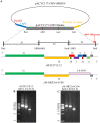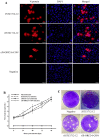Chimeric HP-PRRSV2 containing an ORF2-6 consensus sequence induces antibodies with broadly neutralizing activity and confers cross protection against virulent NADC30-like isolate
- PMID: 34044890
- PMCID: PMC8161975
- DOI: 10.1186/s13567-021-00944-8
Chimeric HP-PRRSV2 containing an ORF2-6 consensus sequence induces antibodies with broadly neutralizing activity and confers cross protection against virulent NADC30-like isolate
Abstract
Due to the substantial genetic diversity of porcine reproductive and respiratory syndrome virus (PRRSV), commercial PRRS vaccines fail to provide sufficient cross protection. Previous studies have confirmed the existence of PRRSV broadly neutralizing antibodies (bnAbs). However, bnAbs are rarely induced by either natural infection or vaccination. In this study, we designed and synthesized a consensus sequence of PRRSV2 ORF2-6 genes (ORF2-6-CON) encoding all envelope proteins based on 30 representative Chinese PRRSV isolates. The ORF2-6-CON sequence shared > 90% nucleotide identities to all four lineages of PRRSV2 isolates in China. A chimeric virus (rJS-ORF2-6-CON) containing the ORF2-6-CON was generated using the avirulent HP-PRRSV2 JSTZ1712-12 infectious clone as a backbone. The rJS-ORF2-6-CON has similar replication efficiency as the backbone virus in vitro. Furthermore, pig inoculation and challenge studies showed that rJS-ORF2-6-CON is not pathogenic to piglets and confers better cross protection against the virulent NADC30-like isolate than a commercial HP-PRRS modified live virus (MLV) vaccine. Noticeably, the rJS-ORF2-6-CON strain could induce bnAbs while the MLV strain only induced homologous nAbs. In addition, the lineages of VDJ repertoires potentially associated with distinct nAbs were also characterized. Overall, our results demonstrate that rJS-ORF2-6-CON is a promising candidate for the development of a PRRS genetic engineered vaccine conferring cross protection.
Keywords: Broadly neutralizing antibodies; Cross protection; Genetic engineered vaccine; Infectious clone; ORF2-6 consensus sequence; PRRSV.
Conflict of interest statement
The authors declare that they have no competing interests.
Figures






Similar articles
-
Minor and major envelope proteins of PRRSV play synergistic roles in inducing heterologous neutralizing antibodies and conferring cross protection.Virus Res. 2022 Jul 2;315:198789. doi: 10.1016/j.virusres.2022.198789. Epub 2022 Apr 26. Virus Res. 2022. PMID: 35487365
-
Systemic Homologous Neutralizing Antibodies Are Inadequate for the Evaluation of Vaccine Protective Efficacy against Coinfection by High Virulent PEDV and PRRSV.Microbiol Spectr. 2022 Apr 27;10(2):e0257421. doi: 10.1128/spectrum.02574-21. Epub 2022 Mar 22. Microbiol Spectr. 2022. PMID: 35315711 Free PMC article.
-
A chimeric strain of porcine reproductive and respiratory syndrome virus 2 derived from HP-PRRSV and NADC30-like PRRSV confers cross-protection against both strains.Vet Res. 2024 Oct 7;55(1):132. doi: 10.1186/s13567-024-01390-y. Vet Res. 2024. PMID: 39375803 Free PMC article.
-
Live porcine reproductive and respiratory syndrome virus vaccines: Current status and future direction.Vaccine. 2015 Aug 7;33(33):4069-80. doi: 10.1016/j.vaccine.2015.06.092. Epub 2015 Jul 4. Vaccine. 2015. PMID: 26148878 Review.
-
Innate and adaptive immunity against Porcine Reproductive and Respiratory Syndrome Virus.Vet Immunol Immunopathol. 2015 Sep 15;167(1-2):1-14. doi: 10.1016/j.vetimm.2015.07.003. Epub 2015 Jul 17. Vet Immunol Immunopathol. 2015. PMID: 26209116 Free PMC article. Review.
Cited by
-
Propidium Monoazide Integrated With qPCR Enables Rapid and Universal Detection of Infectious Porcine Reproductive and Respiratory Syndrome Viruses.Transbound Emerg Dis. 2024 Dec 21;2024:6250851. doi: 10.1155/tbed/6250851. eCollection 2024. Transbound Emerg Dis. 2024. PMID: 40303043 Free PMC article.
-
Ten years after introduction of NADC30-like strain in China: a novel chimeric porcine reproductive and respiratory syndrome vaccine candidate.Front Immunol. 2025 May 8;16:1585197. doi: 10.3389/fimmu.2025.1585197. eCollection 2025. Front Immunol. 2025. PMID: 40406142 Free PMC article.
-
CD163-Expressing Porcine Macrophages Support NADC30-like and NADC34-like PRRSV Infections.Viruses. 2022 Sep 16;14(9):2056. doi: 10.3390/v14092056. Viruses. 2022. PMID: 36146862 Free PMC article.
-
The role of major and minor structural proteins of porcine reproductive and respiratory syndrome virus in induction of protective immunity.Front Microbiol. 2025 Mar 19;16:1563186. doi: 10.3389/fmicb.2025.1563186. eCollection 2025. Front Microbiol. 2025. PMID: 40177477 Free PMC article.
-
Epidemiology and Pathogenicity Analysis Based on Partial Recombinant PRRSV Strains in China.Transbound Emerg Dis. 2025 Aug 13;2025:1748117. doi: 10.1155/tbed/1748117. eCollection 2025. Transbound Emerg Dis. 2025. PMID: 40843276 Free PMC article.
References
-
- Walker PJ, Siddell SG, Lefkowitz EJ, Mushegian AR, Adriaenssens EM, Dempsey DM, Dutilh BE, Harrach B, Harrison RL, Hendrickson RC, Junglen S, Knowles NJ, Kropinski AM, Krupovic M, Kuhn JH, Nibert M, Orton RJ, Rubino L, Sabanadzovic S, Simmonds P, Smith DB, Varsani A, Zerbini FM, Davison AJ. Changes to virus taxonomy and the Statutes ratified by the International Committee on Taxonomy of Viruses (2020) Arch Virol. 2020;165:2737–2748. doi: 10.1007/s00705-020-04752-x. - DOI - PubMed
MeSH terms
Substances
Grants and funding
LinkOut - more resources
Full Text Sources
Other Literature Sources
Research Materials
Miscellaneous

